How To Care For Orchids
THE beauty, complexity and incredible diversity of orchid flowers are unrivalled in the plant world. These exotic beauties comprise the largest family of flowering plants on earth, with over 30,000 different species, and at least 200,000 hybrids. Orchids can be found in the equatorial tropics, the arctic tundra, and everywhere in between. The reason for this diversity lies in the orchid’s amazing ability to adapt to its given environment. With so many different orchid varieties that thrive in so many different growing conditions, it is relatively easy to find an orchid that is well suited to the conditions that you can provide — whether it is a kitchen window or a full-size greenhouse.
Most cultivated orchids are native to the tropics. In their natural habitat, they attach themselves to the bark of trees, or the surface of other plants. Their thick, white roots are specially adapted to absorb moisture and dissolved nutrients. Because these tropical orchids usually grow high in the trees, rather than on the forest floor, they are accustomed to good air circulation and plenty of light. They prefer a 12-hour day, all year-round, and require a high intensity of light — about the same as midsummer conditions in temperate regions.
Are orchids difficult to grow? Many of them are. In fact, some are almost impossible to keep alive, much less bring into bloom—even for professional growers. But there are dozens of varieties of orchids, and hundreds of hybrids, that are perfectly happy growing on a sunny windowsill or under lights.
For your best crack at success, start by choosing one of the less fussy varieties that is adapted to the type of growing conditions you can provide. Buy the most mature plant you can afford (young plants are much more difficult to please), and, if possible, buy it in bloom, so you’ll know what you’re striving for.
How Orchids Grow
Orchids are usually grouped into two broad categories that characterize their growth habits. Monopodial orchids have a single, upright stem, with leaves arranged opposite each other along the stem. The flower stem appears from the base of the uppermost leaves. Orchids with this growth habit include the phalaenopsis and vandas.
The more common growth habit is sympodial. These orchids grow horizontally, sending out new shoots from the old rhizome. Leaves and flower scapes form at the top of the new shoots. Many sympodial orchids form pseudobulbs, which are swollen shoots that store water and nutrients to help the plant survive periods of prolonged drought. Sympodial orchids include cattleya, cymbidium, oncidium and dendrobium.
Orchids can also be classified by their native habitat, which gives an indication of the temperature, moisture and light levels they prefer. Orchids native to the humid tropics, such as phalaenopsis and paphiopedilum, prefer daytime temperatures of 73° to 85°F, with 80 to 90 percent humidity. They are happiest in an east or southeast window where the light is not too intense.
Warm-climate orchids, including cymbidiums and dendrobiums, are accustomed to an average temperature of 55° to 70°F, a steady supply of moisture, and good air circulation. They are generally happy in a south-facing window, though they may need a little shading during high summer.
Cattleyas and some oncidiums grow where days are dry and relatively cool. They are able to tolerate a long dry season with temperatures of 80° or 90°F, followed by a distinct rainy season. Their need for light is high, so they should be placed in a sunny, south-facing window.
High-altitude orchids, such as masdevallia and epidendrum, grow in the cloud forests where average temperatures are 60° to 70°F, and humidity is very high. These orchids prefer filtered light that is not too intense.
With three superbright, full-spectrum fluorescent bulbs per fixture, a LED High Intensity light will provide 50 percent more light than dual-bulb versions.
Caring for Orchids
With 30,000 different species of orchids, it is impossible to give general care and cultivation instructions. However, how an orchid looks can provide clues to its preferences for light, water, and growing medium.
If the plant has few leaves, or leathery leaves (like most cattleyas and oncidiums), it's likely the plant needs a high-light environment. If the leaves are soft and limp (like some phalaenopsis and most paphiopedilum), the plants are probably very light-sensitive, and should not be placed in a sunny south-facing window.
If the orchid has fat pseudobulbs, it should be watered sparingly, and should be grown on coarse chunks of bark or lava rock. If the orchid has no pseudobulbs, it may require more frequent watering, or should be grown in a more moisture-retentive growing medium, such as sphagnum moss.
Light: As a general rule, orchids are light-hungry plants. For best results, they should get 12 to 14 hours of light each day, year-round. In a tropical environment, the duration and intensity of natural light does not vary as it does in temperate climates. For this reason, you may need to move your orchids around, and supplement with artificial light to keep them happy during the winter months.
South- and east-facing windows are usually the best spot for orchids. West windows can be too hot, and northern ones are usually too dark. If you don’t have a good window location for your orchids, they will be perfectly happy growing under artificial lights. Orchids should be positioned no more than 6 to 8 inches away from a set of 4-foot fluorescent bulbs. Opinions vary as to the benefits of cool white, warm white, and grow light bulbs. The new full-spectrum bulbs are probably the best all-around choice. Some orchids with very high light requirements, such as vandas and cymbidiums, may need high-intensity discharge lighting in order to flower.
Growing media: Terrestrial orchids, such as paphiopedilums and some cymbidiums, grow in soil. But most tropical orchids are epiphytes, which means that they grow in the air, rather than in soil. Their fleshy roots are covered with a layer of white cells called velamen, which acts as a sponge to absorb water. The coating also protects the roots from heat and moisture loss.
An orchid growing medium must provide good air circulation and permit water to drain very quickly. It must also give the roots something secure to cling to. Depending on the type of orchid, they can be happy growing New Zealand Orchiata Bark, in peat moss, fir bark, dried fern roots, sphagnum moss, rock wool, perlite, cork nuggets, stones, coconut fiber, lava rock or a blend that combines several of these materials. Some epiphytic orchids can also be wired onto slabs of tree fern or cork. As a general rule, fir bark nuggets are the most popular growing medium.
Watering: Most orchids can tolerate drought far better than they can tolerate excess moisture. Nothing kills an orchid faster than letting it sit in a water-logged pot. Without adequate air circulation, the plant will suffocate and die.
As a very general rule, orchids should be watered once a week. The growing medium should be allowed to dry out between waterings, and excess water should not come in contact with the roots or the growing medium. After being re-potted, most orchids will not resume active growth for several months. Water very sparingly during this readjustment period. Using a specially designed orchid pot will make it easier to keep plants watered properly.
Humidity: Most tropical orchids prefer humidity levels of 60 to 80 percent. With the winter-time humidity level in most homes hovering closer to 30 percent, orchid growers often use a humidifier, or set their orchids in special humidity trays or gravel-filled trays. Some orchids also benefit from being misted.
Fertilizer: Orchid-growing mediums provide very few nutrients, so orchids must be fertilized to sustain healthy growth. Use a liquid fertilizer, and dilute it more than you would for other plants. Fertilizer should only be applied when plants are in active growth. This means that most orchids should not be fertilized in midwinter, or right after they have been re-potted. Many growers use a 30-10-10 fertilizer, though others prefer 10-10-10 or 10-10-30. Misting your orchids with fish emulsion or seaweed extracts will provide micronutrients.
Potting and re-potting: Orchids are usually happiest in a relatively small pot. Plastic pots are preferred because when it’s time to re-pot, the roots can be more easily detached, or the pots can simply be cut apart. To ensure good drainage, you can fill the bottom inch or two of the pot with foam “peanuts.” Suspend the orchid over the pot, and gradually fill the pot with fir bark chunks or whatever other growing medium you are using. The crown of the plant should be just a bit below the top of the pot. Sometimes it's helpful to use a bit of wire to secure the plant until its roots get established.
Some orchids should be re-potted every year. Others may be happy in the same pot for seven or more years. As a general rule, don’t re-pot your orchid unless necessary. Orchids resent being disturbed. Re-pot if the growing medium has started to break down enough to reduce aeration; if the roots are creeping out well beyond the pot; or if new growth has unbalanced the plant.
Propagation: Propagating orchids from seed is quite difficult. Unlike the seeds of other plants, orchid seeds do not contain nutritional storage tissues. To grow, the seed must land where it will find a particular kind of fungi that can penetrate its root system and convert nutrients into a usable form. To overcome the odds, an orchid seed capsule typically disburses millions of microscopic seeds, which can be carried hundreds of miles from the mother plant.
To propagate orchids from seed, you must work in sterile conditions. The seeds must be grown in a gelatinous substance that contains nutrients and growth hormones. You must also be very patient. It takes months for the first leaves to develop, and, even then, they will only be visible with a magnifying glass. Roots appear even later. It will be at least three, and possibly as many as eight years before you see a bloom.
It is far easier to propagate orchids by division. But remember that dividing a plant means forsaking blooms for at least a year. Also, the larger the orchid plant, the more flowers it will produce. Small divisions take many years to mature.
Orchid Facts
Unlike other plants and animals, orchids can produce hybrids between species, and also between related genera. This permits a mind-boggling number of hybrids, and is the reason for the very complex names given to most orchids.
- Most orchids bloom once a year, but if they are really happy, they may bloom more often. If you want an orchid that blooms during a particular season, the best bet is to purchase a plant that is in bloom at that time.
- When an orchid does flower it usually remains in bloom for six to ten weeks.
- Orchids resent re-potting, and usually will not flower for at least a year after they have been disturbed. If possible, purchase your orchids in pots, rather than bareroot.
PLEASE CONTINUE TO SCROLL DOWN
A large thank you to the American Orchid Society for the voices to pronounce the names of the orchids.
Angraecum 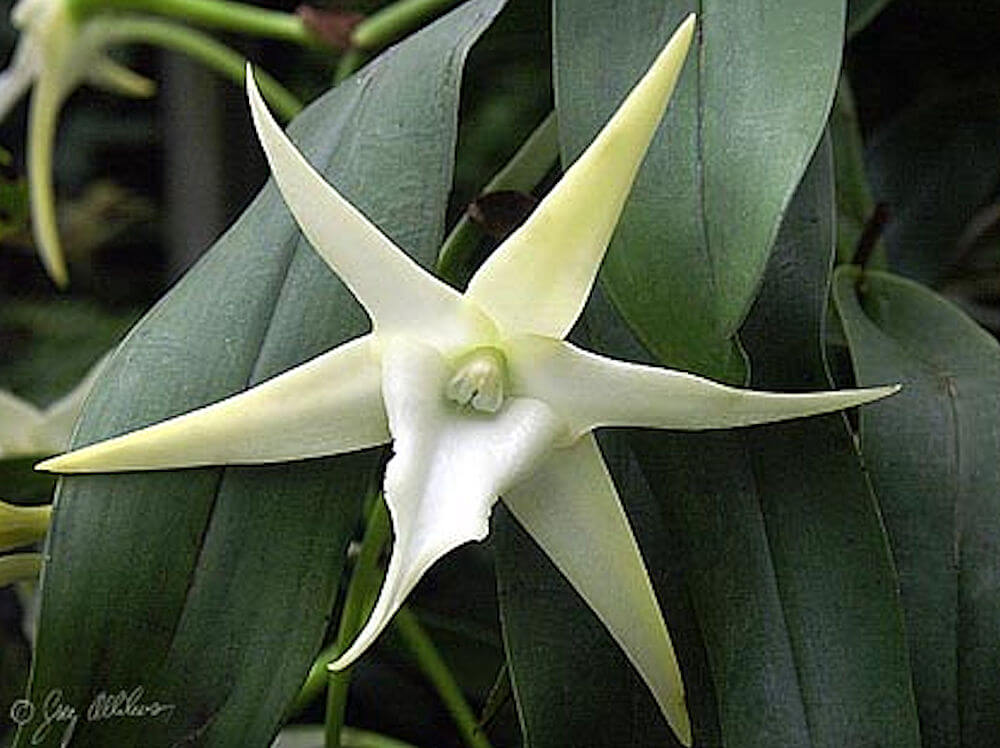

Angraecums, approximately two hundred species of white or greenish, generally star-shaped flowers, are typically monopodial in growth habit and are mostly epiphytic. Some Angraecum species are only a few inches high while others can reach over 6 feet. Perhaps most famous is Angraecum Sesquipedale.
Pronounce the name Angraecums
Brassavola 
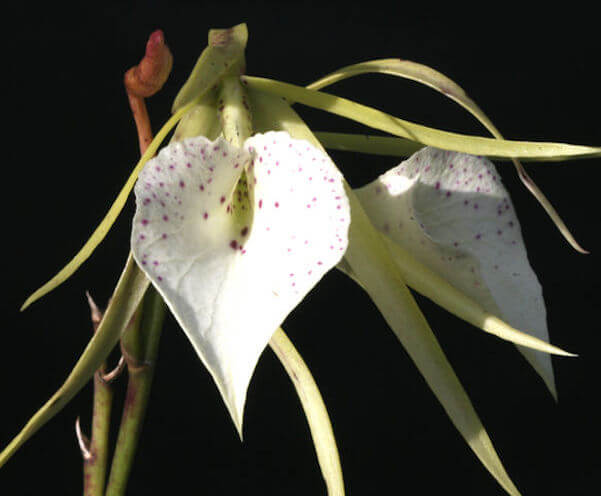
The "lady of the night" orchid, so named for its delightful fragrance in the evening is a wonderful addition to any orchid collection. It has stout terete leaves which emerge along a central rhizome. From the new growth comes elegant white flowers in early winter. When the sun goes down, the fragrance emerges to fill the entire room. Brassavola can be grown on an orchid mount or in a pot.
Pronounce the name Brassavola
Catasetum 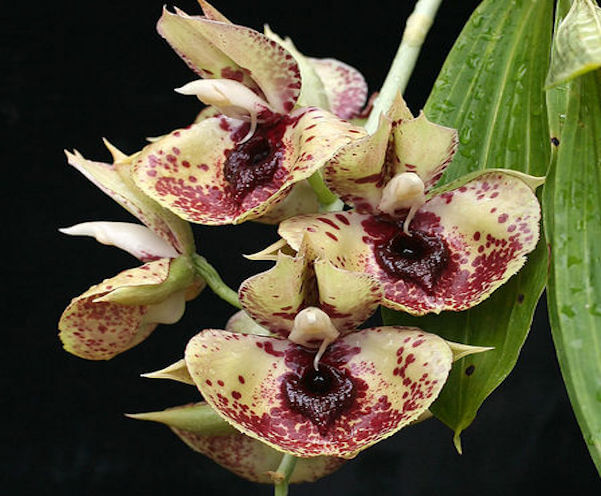

Catasetum are unique and most unusual orchids. Deciduous in nature, they require a distinct winter dry rest. When they bloom the large waxy flowers will be either male or female. The male flowers are typically showier and are produced at lower light than required for female flowers. If the flower is bumped the pollen is literally ejected into the air.
Pronounce the name Catasetum
Cattleya 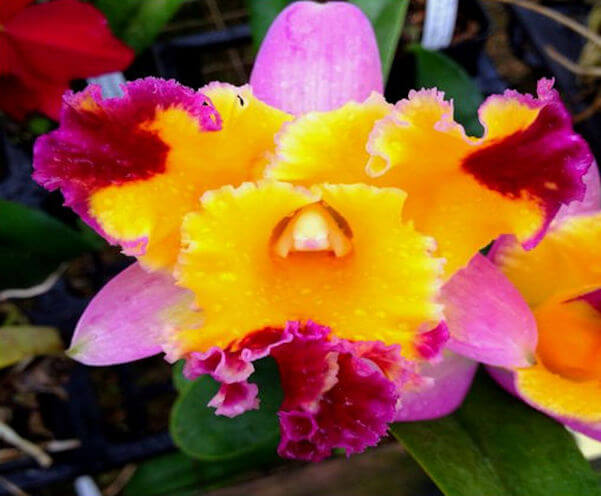

The corsage orchid is a popular and rewarding orchid to grow. It has large tall growths called pseudobulbs that are topped with a leaf growing one after another to produce the next season's bloom. The pseudobulbs are connected to each other by a horizontal growth that is at or just under the surface of the media called a rhizome. When repotting, a rhizome clip may be required to secure the orchid in its pot. Cattleya orchids are usually repotted when they have finished blooming and a new pseudobulb is just starting to grow.
Pronounce the name Cattleya
Miniature Cattleya 
The miniature cattleya is a fraction of the size of its big brother, the Cattleya. Often less than 8" tall, the mini cattleya takes far less space than the standard cattleya which is twice as tall and requires a much larger pot. The miniature cattleya have multiple petite blooms that look remarkably like cattleya blooms except for their smaller size. The miniature cattleya has the same pseudobulb growth habit as the standard cattleya and is best repotted right after blooming as the new growth begins to emerge. We will usually select a smaller media size for our miniature cattleya, potting them in a seedling mix.
Pronounce the name Cattleya
Coelogyne 

This popular genus has pseudobulbs with one or two pleated leaves. These pseudobulbs vary in size and are mostly of an ovoid shape and can be closely or widely spaced on the rhizome. The leaves may also be closely spaced or far apart. In reference to the hollow stigmatic area on the column, he named the genus from two Greek words: koilos (hollow) and gyne (female). The species of Coelogyne are popular in collections due to their mostly fragrant, free flowering, showy inflorescences. Those most often found include C. cristata, C. speciosa, C. fimbriata, C. massangeana and C. dayana..
Pronounce the name Coelogyne
Cycnoches 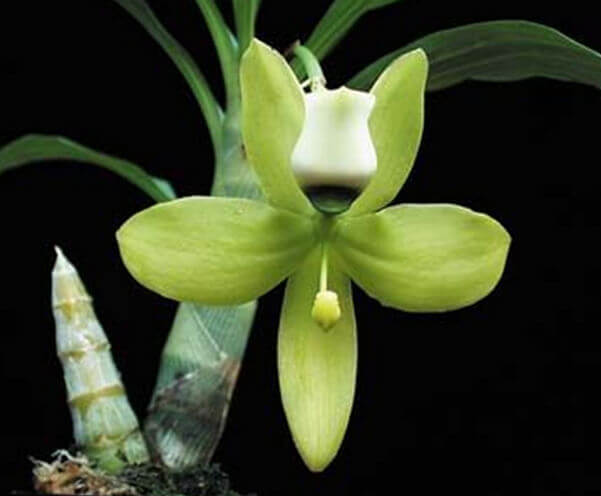

A member of the Catasetum tribe, the waxy and fragrant blooms of Cycnoches are a delight in the early fall. The care for these wonderful orchids is similar to Catasetum including a dry winter rest. From tall pseudobulbs and leaves that lean forward in a fan shape comes an arching inflorescence of blooms with incredible substance. Yellows, reds, greens, they are all a wonderful addition to any collection. They bloom early in the fall, basically in late summer, when not much else is happening.
Pronounce the name Cycnoches
Cymbidium 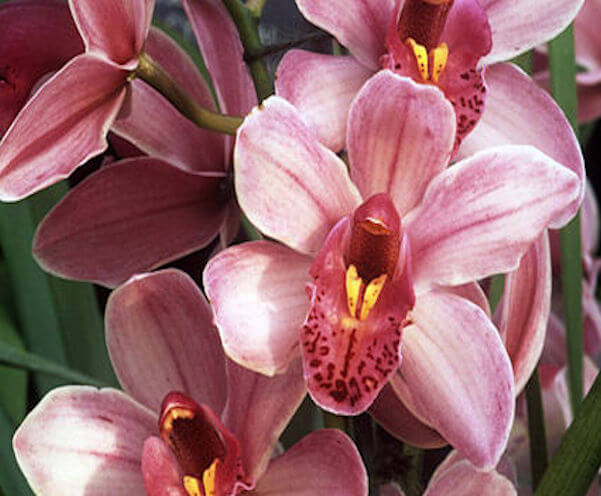
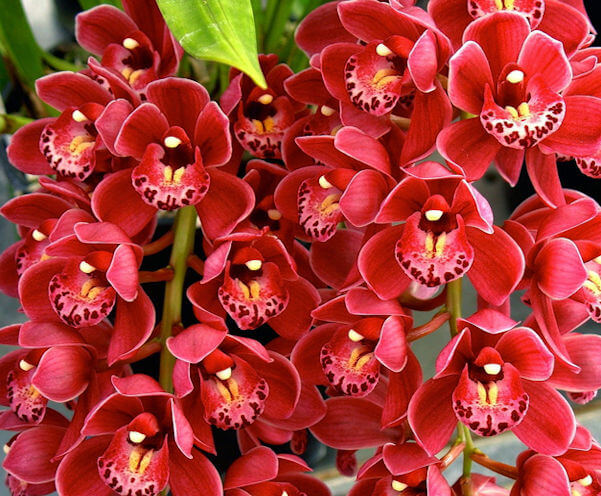
Often large, hairy and unruly, the Cymbidium orchid delights with tall spikes loaded with flowers. This pictured plant is about three feet tall and ready to go into the next size container. The Cymbidium orchid has much smaller pseudobulbs that are topped with long thin leaves that gently drape to form an attractive foliage plant. In warm climates Cymbidiums grow outdoors year-round and spread out to be quite spectacular. Similar to most other orchids, Cymbidiums prefer to be repotted shortly after blooming as the new growth is beginning to emerge.
Pronounce the name Cymbidium
Miniature Cymbidium 
Miniature Cymbidiums are a mere fraction of the size of their standard counterparts making them a workable alternative for growing inside the home.
Pronounce the name Cymbidium
Dendrobium 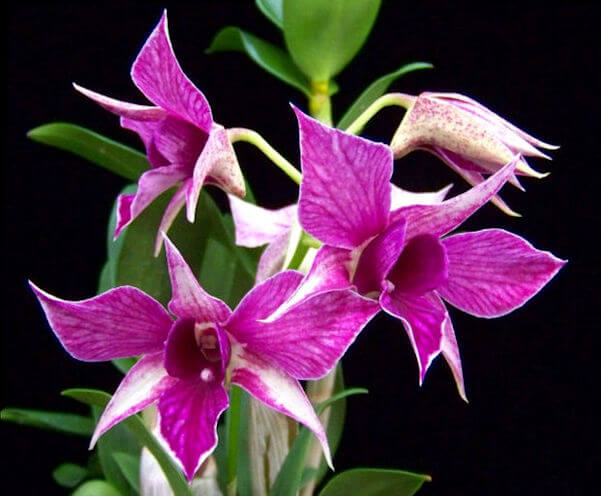
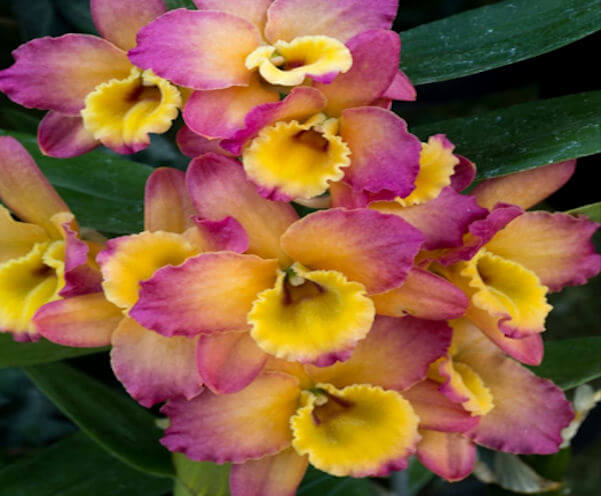
Dendrobiums are tall and stately with elongated pseudobulbs topped by modest sized leaves. Their graceful sprays of flowers are a welcome break during winter's grey days. Even after the leaves fall from the oldest pseudobulbs they continue to provide sustenance to the plant and should be retained during repotting unless they are quite shriveled.
Dendrobiums like to grow in a very small pot, often the pot looks ridiculously small compared to the height of the plant. This presents some unique problems with growing Dendrobiums; they are top-heavy. Some solutions to this are to plant them in clay pots or to use broken brick, cobblestone or pea gravel in the bottom of the pot to weigh it down. Precise staking of Dendrobiums to make them well balanced is also critical.
Dendrobiums often resent repotting and in extreme cases can be killed if repotted at the wrong time. Repot only when new growth begins to appear.
Pronounce the name Dendrobium
Miniature Dendrobium 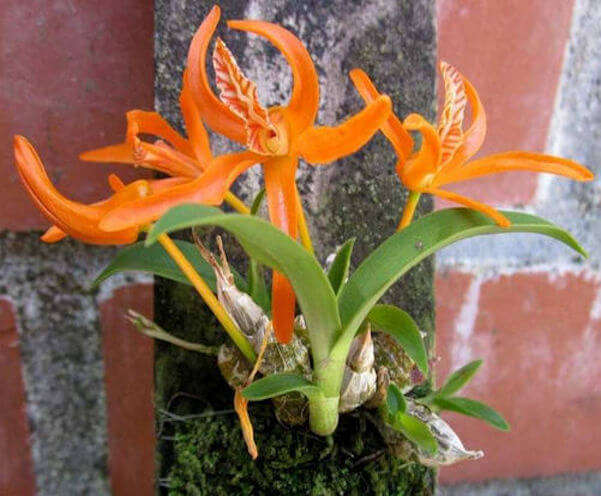
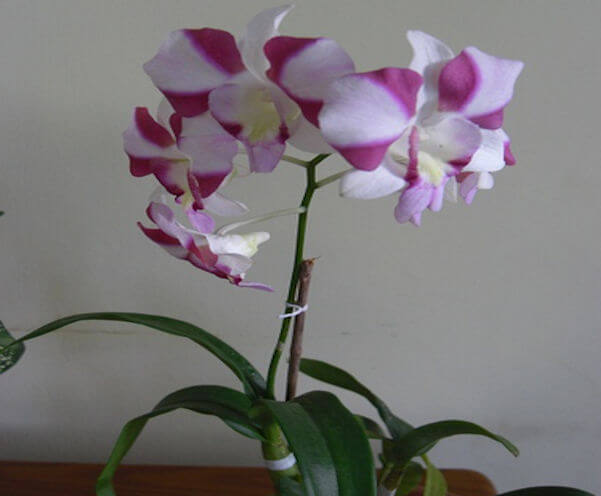
A delightful and floriferous orchid, a common variety is a Dendrobium Bigibbum hybrid. Small in stature yet covered with blooms, these miniature dendrobiums are a pleasure to grow. Care is similar to standard Dendrobiums yet they are not top-heavy and often don't require staking. Miniature Dendrobiums are about 8 inches tall compared to standard Dendrobiums which can easily exceed 3 feet for a mature plant.
Pronounce the name Dendrobium
Epidendrum 

Delicate fragrant blooms atop chunky rounded pseudobulbs, the epidendrum is a delightful orchid. It's high light requirements, however, can make it difficult to rebloom in the home. Supplemental artificial light or summers outdoors help meet its needs.
Pronounce the name Epidendrum
Encyclia 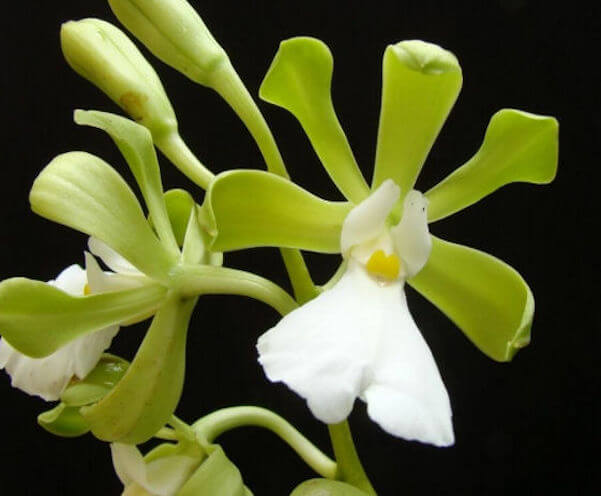
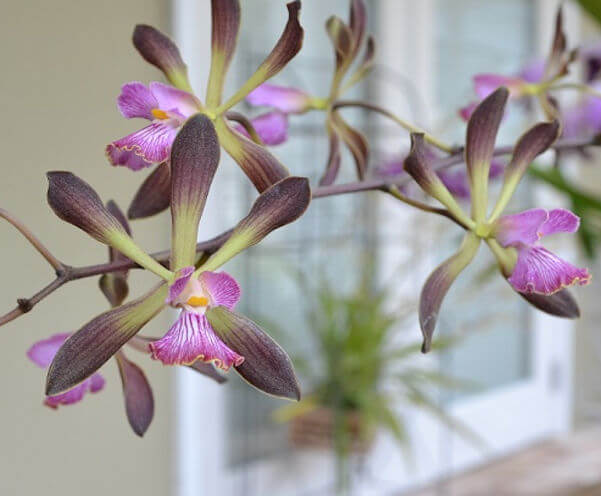
The cockleshell orchid has wispy blooms topped with a dorsal sepal that looks like a seashell. Spikes come from the top of the pseudobulbs in the winter or early spring. Blooms open successively along the spike allowing the encyclia to stay in bloom for a long time.The Encyclia orchid prefers to be repotted when a new pseudobulb is beginning to grow.
Pronounce the name Encyclia
Grammatophyllum; 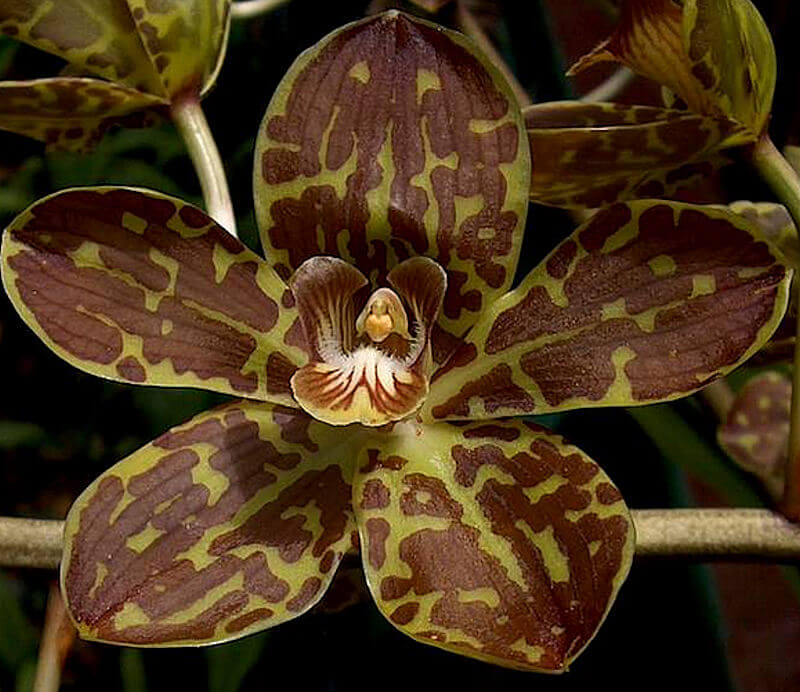

The generic epithet is from the Greek gramma = letter and phyllon = leaf and refers to the conspicuous markings on the floral segments. Type species for this genus is the very large Grammatophyllum speciosum. There are two distinct growth forms in this genus: one with long spindle-like pseudobulbs reaching several metres in length; the others with distinct ovate pseudobulbs. Commonly seen species are Grammatophyllum scriptum and Grammatophyllum stapeliiflorum. All are very showy species.
Pronounce the name Grammatophyllum
Huntleya; 
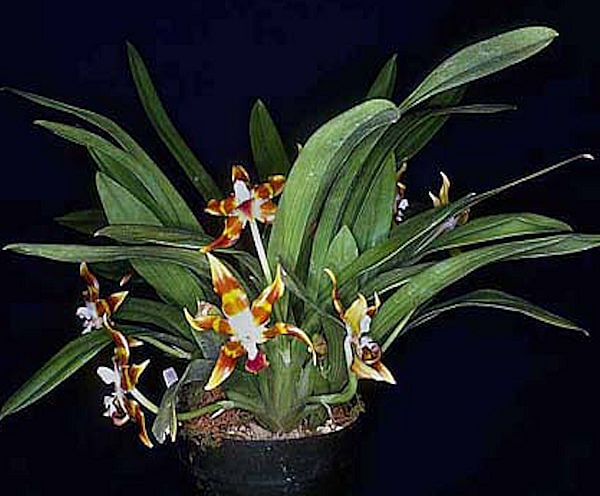
This genus was named to honor Reverend J. T. Huntley, an English orchid fancier. The fan shaped plants of Huntleya are rhizomatous epiphytes distributed from Costa Rica to Bolivia in extremely wet cloud forests at elevations from 500 to 1,200 meters (600-4000 feet). Similar to other closely related genera, flowers emerge from between the leaf sheathes and the creeping plants lack pseudobulbs. The sepals and petals are generally similar and spreading, the lateral sepals are basally adnate to a column foot forming a short mentum and the petals are inserted obliquely into the column. The flowers of Huntleya have a two part lip; the hypochile with a fimbriate callus and the epichile with a mostly flat surface. Number of species currently at 14.
Pronounce the name Huntleya
Intergeneric Orchids 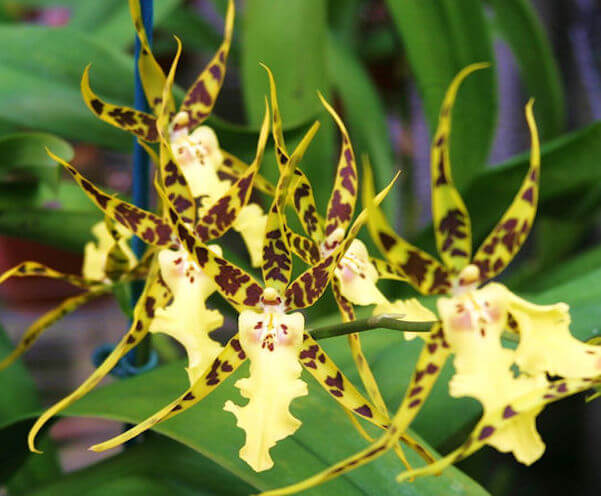
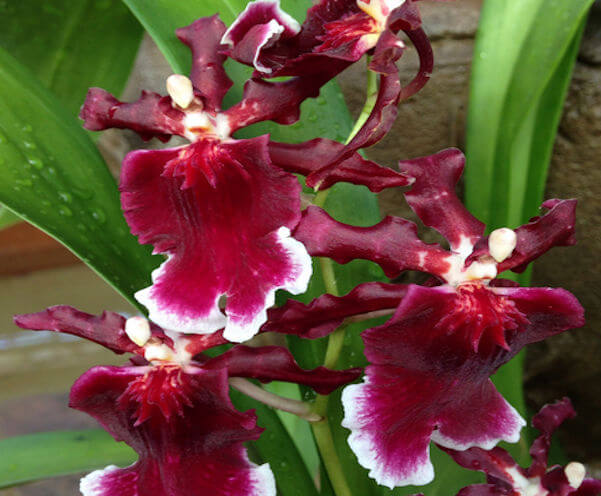
When several different genera are crossed together, the result is called an Intergeneric. These orchids often have very striking and unusual flowers as a result of creative man-made combinations.
Intergeneric orchid care and background can be generalized as similar to Oncidiums. For a precise guide to their care one must research the parents. Given all the hybridization that has occurred, however, many of the idiosyncrasies of the parent's culture often has been bred out of these plants.
Like most orchids, Intergenerics prefer to be repotted after blooming as new growth emerges. They also prefer to be in a fairly tight pot.
Jumellea 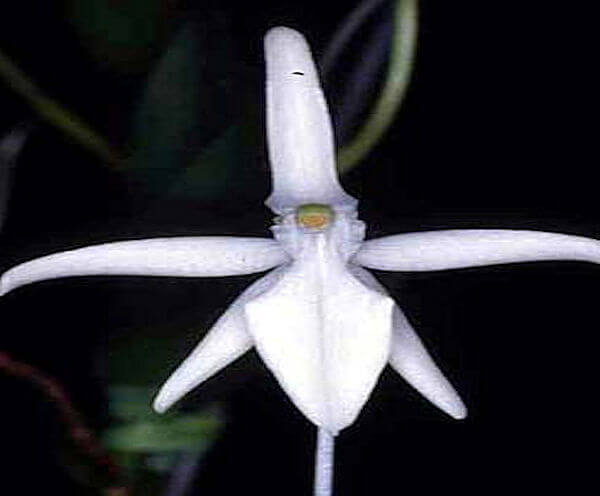
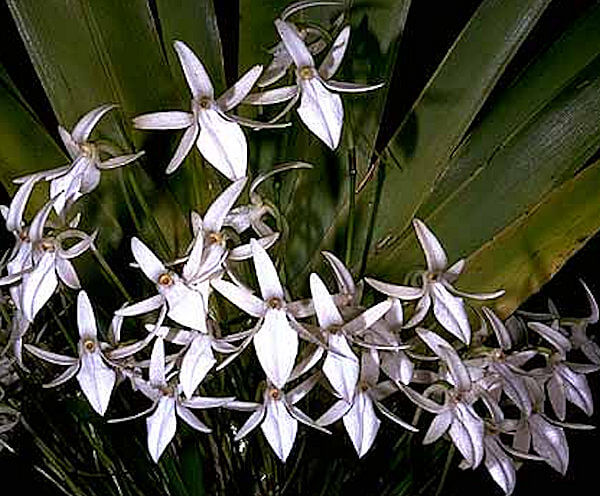
Named in honour of Dr. H. Jumelle, Jumellea is a genus of white-flowered often night-fragrant species. Possibly the best known in collections is Jumellea sagittata but Jum. fragrans (Mauritius) and J. comorensis (Comoros) are also popular because of their showy fragrant blooms. Jumellea plants exhibit a monopodial habit. Offsets can form at the base of a plant with age. Some plants grow upright while others such as 18 in tall Jum. arborescens exhibit a vining habit. Jumellea sagittata produces fans of strap-like leaves such that with age it can become a large handsome specimen. Showy flowers, one to a stem, are produced from the leaf axils. Many species grow at 3000 to 6000 ft in elfin or lichen forest where there are high winds or at lower elevations in moist wet moss forest. About 60 to 80 species and sub-species.
Pronounce the name Jumellea
Ludisia 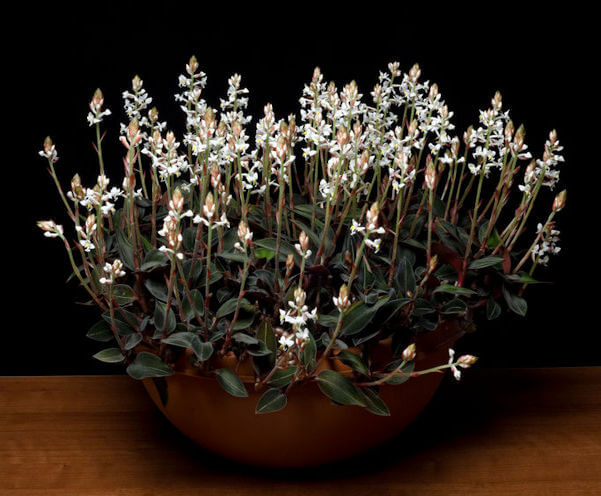
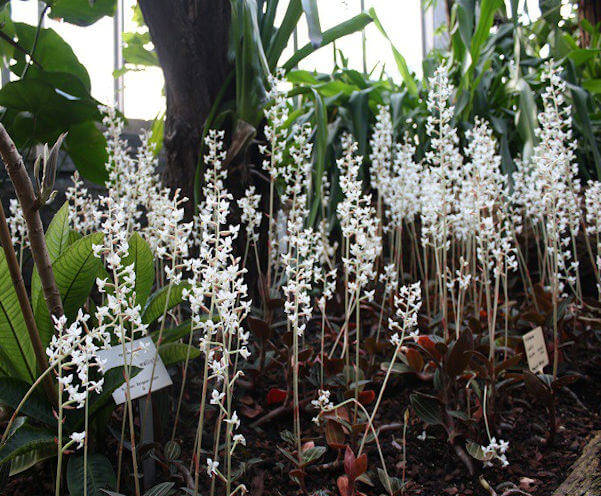
Ludisia Discolor, the "Jewel Orchid" has extraordinary foliage. Grown more for its leaves than for its diminutive flowers, this orchid is often found growing as a common houseplant. Ludisia grows very quickly once established. It is a terrestrial orchid that prefers a fast draining soil-less potting mix like our Orchiata New Zealand Orchid Bark.
Pronounce the name Ludisia
Masdevallia 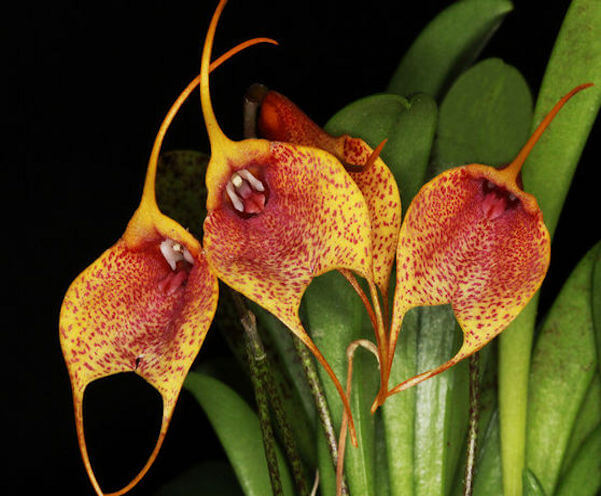
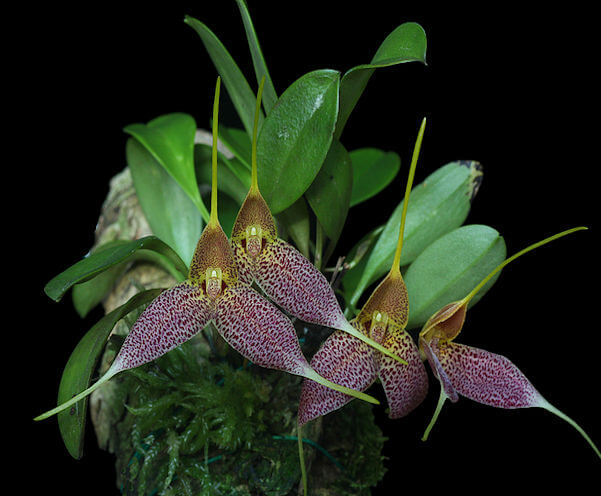
Masdevallia blooms are strikingly unique. Three fused sepals form a triangular shape hiding the petals and lip from view. Ordinary looking leaves top tiny pseudobulbs making this orchid look much like a common houseplant when not in bloom. These miniature orchids are a pleasure to grow and bloom in the summer when not much else is happening in an orchid collection.
Pronounce the name Masdevallia
Miltonia 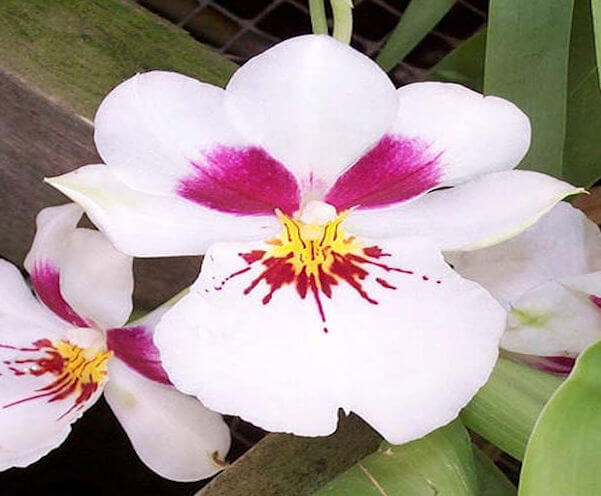
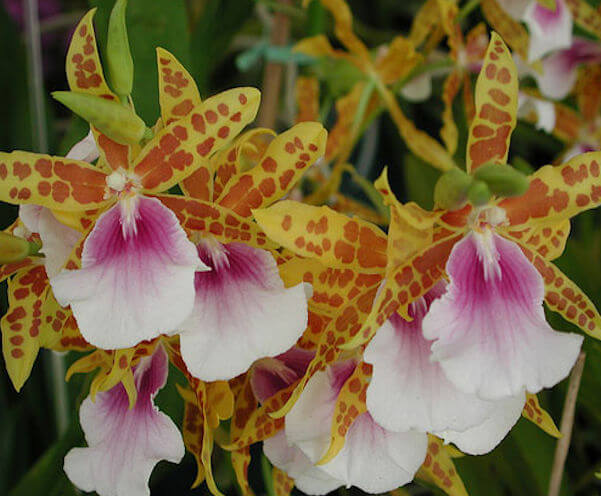
Miltonia, is a wonderful spring to summer blooming orchid. These orchids bear a string of flowers that seem almost too large for the size of their foliage. Sometimes referred to as the 'pansy orchid' it is Miltonopsis that has the real broad pansy-like faces. Miltonia are more warm tolerant and easier to grow than the cooler growing Miltonopsis, though the two are often confused. Miltonia like to be kept evenly moist and prefer a free draining bark or New Zealand sphagnum moss.
Pronounce the name Miltonia
Miltassia 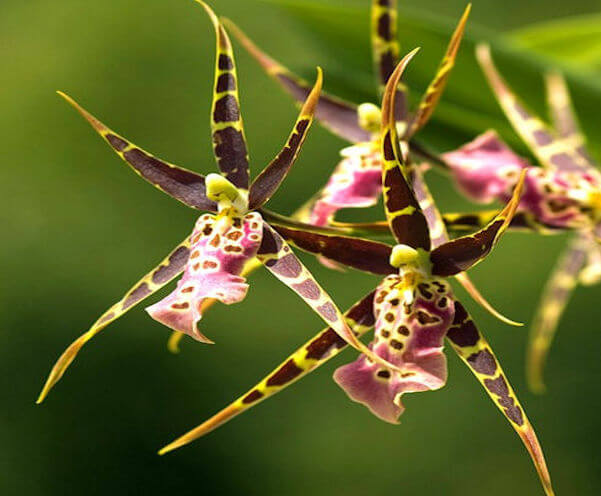

Miltassia is an intergeneric orchid, Miltonia crossed with Brassia. Intricate bloom colors and patterns from the Miltonia side crossed with the spidery nature and scents of Brassia make for some unusually beautiful flowers. Care is similar to Oncidiums. Repot as new growth forms in a fine grade Orchiata bark.
Pronounce the name Miltassia
Oncidium 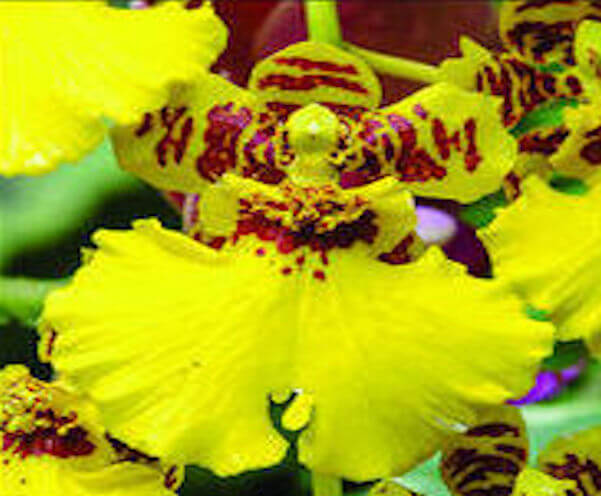
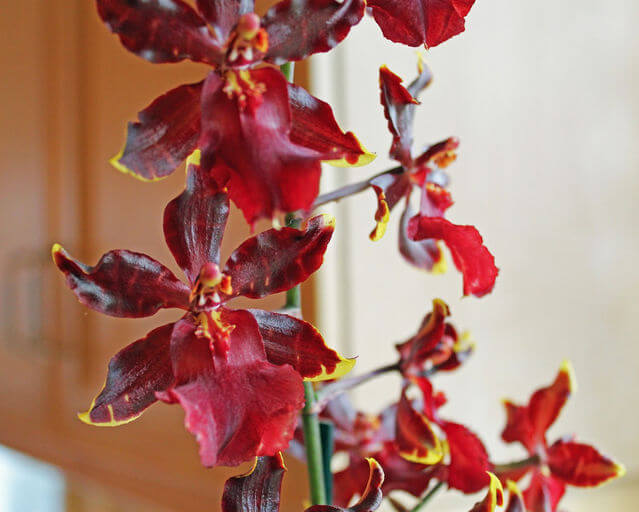
The Dancing Lady orchid delights with brilliant sprays packed with flowers. Yellow, tricolor, or the popular red sharry baby (that smells like chocolate), these are orchids easy to grow. Oncidiums have a habit of growing up and out of the pot as though they are trying to grow up a tree trunk. Oncidiums like to be evenly moist and if subjected to periods of dryness will grow leaves that have an "accordion" look to them. One option is to layer a bit of sphagnum moss on top of the media to increase humidity, just be careful that it is below the level of the pseudobulbs.
Pronounce the name Oncidium
Miniature Oncidium 
Miniature Oncidiums, the most popular being Oncidium Twinkle, have a remarkable number of flowers for such a small plant.
Miniature Oncidiums prefer to be in a small, tight pot and will dry out very quickly. It is a bit of a challenge keeping these little guys moist enough. Still, they are relatively easy to grow and have a generous bloom. Unlike standard Oncidiums, the miniature varieties are less likely to attempt to grow up and out of the pot. These are diminutive plants, usually 6 inches or less in height.
Pronounce the name Oncidium
Phaius 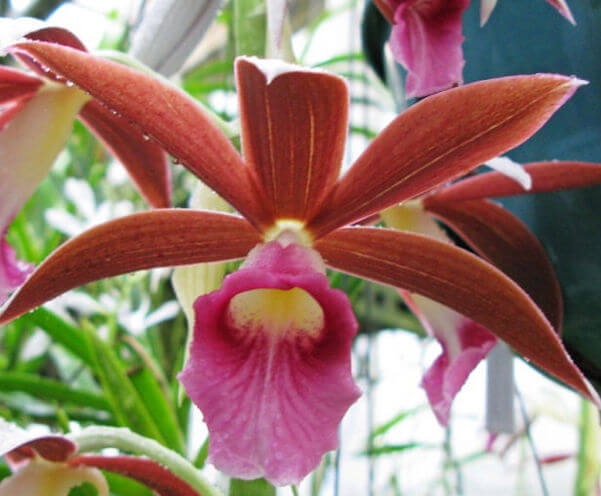
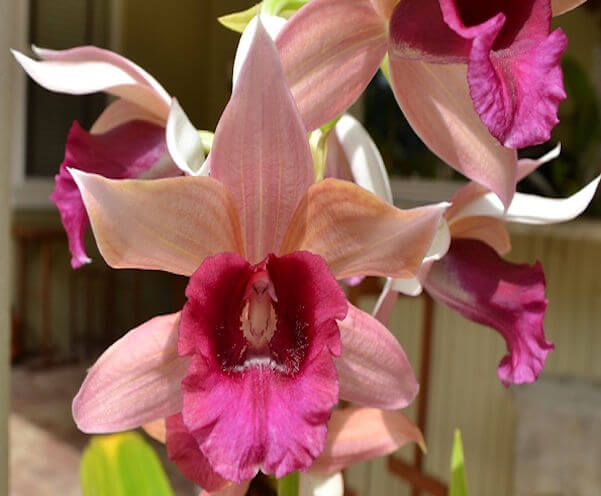
The "Nun Orchid" or "Nun's Cap Orchid" is a beautiful broad leaf terrestrial orchid of the genus Phaius. This orchid can grow outside year-round in freeze-free areas. In colder climates this orchid enjoys summers outside and should come indoors before night temperatures drop below 40 degrees. In winter it will develop tall bloom stems topped with many beautiful blooms.
Pronounce the name Phaius
Paphiopedilum 
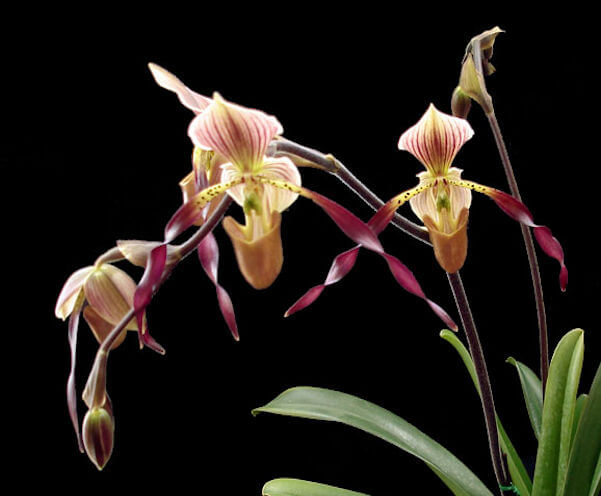
The Lady Slipper orchid holds a special appeal for many orchid growers. Terrestrial in nature, Paphiopedilums grow in the loamy detritus on the jungle floor. Paphs have been called the "ultimate houseplant" for their ease of growth in the home. The new growth on a Paph consists of a "fan" of new leaves that emerges from the base of the previous fan. There is no pseudobulb and therefore Paphs have no water reservoir to fall back on during dry times. As a result, the paph grower tries to keep a delicate balance between keeping the plant moist enough yet not too moist. Potting media made especially for Paphs can help maintain this balance.
Pronounce the name Paphiopedilum
Phalaenopsis 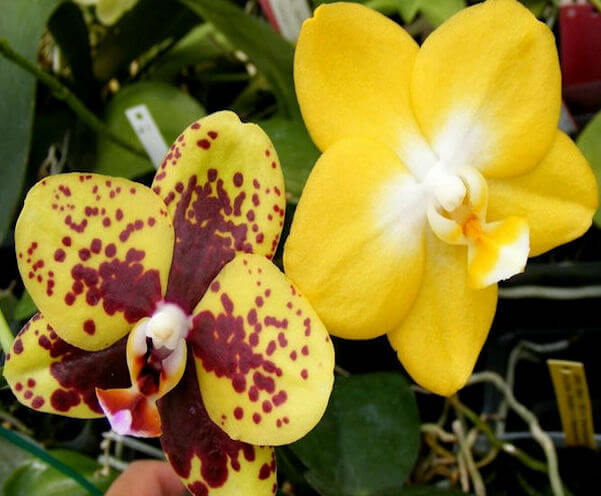
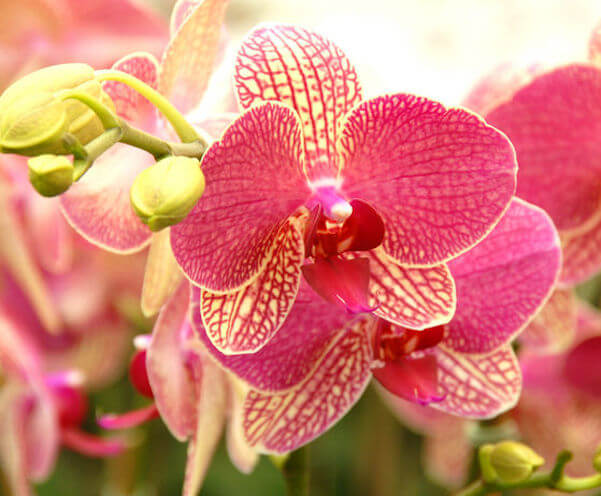
The Moth orchid is the most common orchid due to its ease of production and the ability to force it to bloom year-round. Phals are easily grown in the home and stay in bloom for a very long time. A mature phal will be in bloom much of the year with graceful inflorescences loaded with good-sized blooms. From pure whites to unusual spotted harlequins, phals are sure to please.
Pronounce the name Phalaenopsis
Phragmipedium 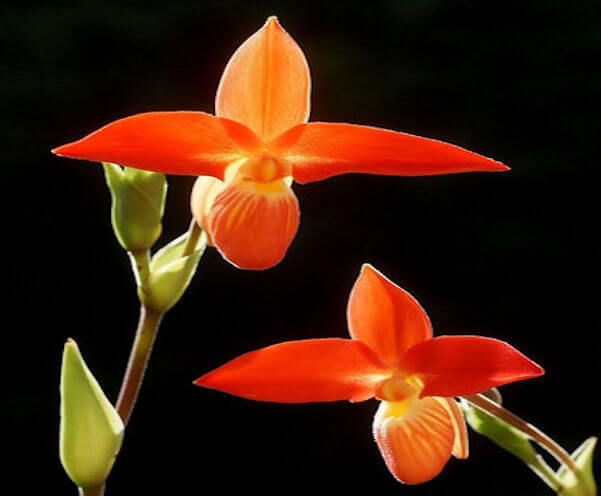
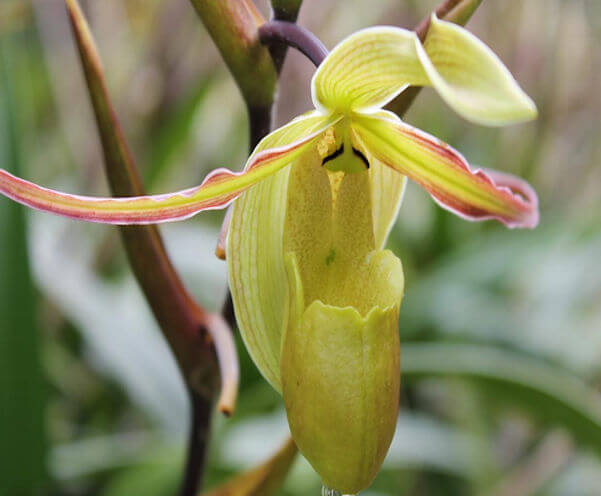
Phragmipedium love water. In fact, they love water so much that they prefer to continually have 'wet feet'. This is in stark contrast to the vast majority of other orchids. Many of these orchids live along the splash zone of streams in nature. The bloom of the phragmipedium is very similar to that of the Paphiopedilum and resembles a lady's slipper. Offspring of Phrag. besseae bear brilliant reds not found in other ladyslipper orchids.
Pronounce the name Phragmipedium
Psychopsis 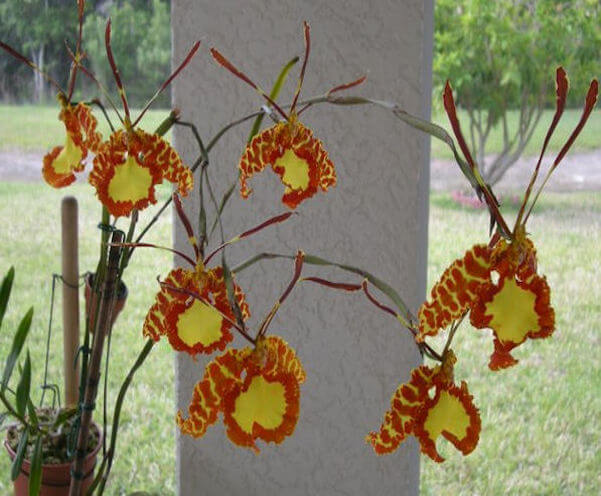

The Butterfly orchid (Oncidium Papilio) is a unique and fanciful orchid with attractive foliage and blooms atop very tall spikes that look like butterflies dancing in the breeze. Blooms are born sequentially on the same spike for many months. Psychopsis are relatively easy to grow in the home and seem to tolerate a range of light conditions quite well. They can be fussy about repotting yet don't like to grow in broken down or sour mix either. Repot only as new growths appear.
Pronounce the name Psychopsis
Sarcochilus 

The Sarcochilus is a wonderful miniature orchid native to Australia. Most are lithophytes and like moist conditions without drying out yet they don't like 'wet feet'. They can be grown successfully in conditions ranging from those for Phalaenopsis to Cattleya. Sarcochilus is a monopodial orchid, like its close relative the Phalaenopsis. These little orchids freely grow new clumps and bloom profusely in the spring.
Pronounce the name Sarcochilus
Vanda 

The Vanda is a delightful and unique orchid to grow. Unlike many other orchids, Vandas are most often seen growing in baskets with their roots hanging down in mid air. Vandas can be a bit of a challenge to grow in the home because of their high light and high humidity requirements. Given favorable conditions, Vandas will bloom a few times per year. Vandas grow either alone in a Vanda Basket or in a basket with Large Coconut Husk Chips or Chunky Cattleya Blend to provide additional moisture and humidity. For stability within the basket, Coconut Husk Fiber and Large Cork Chunks are excellent choices.
Pronounce the name Vanda
